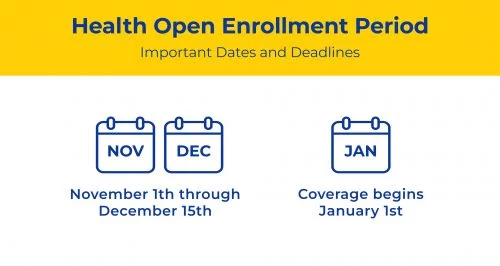UPDATED: OCTOBER 04, 2023 | 2 MIN READ

Open enrollment is typically a time of change; it’s when you get to either buy a different insurance plan or change the health insurance plan that you currently have.
How open enrollment works for you depends on how you obtained your insurance. Many people get their insurance through their job, and business insurance varies.
The company makes the decisions when it comes to your health insurance. It’s always good practice to check with your human resources department to determine when your company holds open enrollment.
- If your health insurance isn’t through your employer, here are some things to jot down:
- If you have Medicare, you make changes between October 15 and December 7 or the limited open enrollment from January 1 to March 31.
- The Affordable Care Act provides open enrollment for individuals between November 1 and January 15. There are a few states that hold open enrollment.
Below, we’ll walk you through everything you need about open enrollment 2024.

When is Open Enrollment for 2024 health coverage?
For most states, open enrollment in 2024 begins on November 1, on January 15. New York generally delays the start of their open enrollment until November 15, but they have an extended deadline. Idaho also starts open enrollment on October 15, 2022, and ends on December 15, 2022.
It’s important to note that most states want enrollments completed by December 15, 2023, to take effect on January 1, 2024. If you’re running late to the game, don’t freak out, as it’s common to see extensions to the deadline. Any enrollment completed after December 15, 2023, doesn’t go into effect until February 1, 2024.
Important Open Enrollment dates
- November 1, 2023: Open Enrollment starts — the first day you can enroll in, re-enroll in, or change a 2024 health plan through the Health Insurance Marketplace®. Coverage can start as soon as January 1, 2024.
- December 15, 2023: Last day to enroll in or change plans for coverage to start January 1, 2024.
- January 1, 2024: 2024 coverage starts for those who enroll in or change plans by December 15, 2022.
- January 15, 2024: Last day to enroll in or change a 2024 health plan. After this date, you can enroll in, or change plans only if you qualify for a Special Enrollment Period.
- February 1, 2024: 2024 coverage starts for those who enroll in or change plans from December 16, 2023, through January 15, 2024.
| States | Federal Open Enrollment Period for 2024 Plans |
|---|---|
| Alabama | November 1, 2023 – January 15, 2024 |
| Alaska | November 1, 2023 – January 15, 2024 |
| Arizona | November 1, 2023 – January 15, 2024 |
| Arkansas | November 1, 2023 – January 15, 2024 |
| Delaware | November 1, 2023 – January 15, 2024 |
| Florida | November 1, 2023 – January 15, 2024 |
| Georgia | November 1, 2023 – January 15, 2024 |
| Hawaii | November 1, 2023 – January 15, 2024 |
| Illinois | November 1, 2023 – January 15, 2024 |
| Indiana | November 1, 2023 – January 15, 2024 |
| Iowa | November 1, 2023 – January 15, 2024 |
| Kansas | November 1, 2023 – January 15, 2024 |
| Louisiana | November 1, 2023 – January 15, 2024 |
| Michigan | November 1, 2023 – January 15, 2024 |
| Mississippi | November 1, 2023 – January 15, 2024 |
| Missouri | November 1, 2023 – January 15, 2024 |
| Montana | November 1, 2023 – January 15, 2024 |
| Nebraska | November 1, 2023 – January 15, 2024 |
| New Hampshire | November 1, 2023 – January 15, 2024 |
| North Carolina | November 1, 2023 – January 15, 2024 |
| North Dakota | November 1, 2023 – January 15, 2024 |
| Ohio | November 1, 2023 – January 15, 2024 |
| Oklahoma | November 1, 2023 – January 15, 2024 |
| Oregon | November 1, 2023 – January 15, 2024 |
| South Carolina | November 1, 2023 – January 15, 2024 |
| South Dakota | November 1, 2023 – January 15, 2024 |
| Tennesee | November 1, 2023 – January 15, 2024 |
| Texas | November 1, 2023 – January 15, 2024 |
| Utah | November 1, 2023 – January 15, 2024 |
| Virginia | November 1, 2023 – January 15, 2024 |
| West Virginia | November 1, 2023 – January 15, 2024 |
| Wisconsin | November 1, 2023 – January 15, 2024 |
| Wyoming | November 1, 2023 – January 15, 2024 |
For many Americans, open enrollment is the only time to enroll in an ACA-compliant health insurance plan without a qualifying event.
A qualifying event is a special circumstance that allows you to enroll in a health insurance plan outside the Open Enrollment Period.
Qualifying life events that trigger ACA Special Enrollment Period
- Marriage
- Involuntary loss of coverage
- Divorce
- Individual plan renewing outside of the regular open enrollment
- Gaining access to QSEHRA or Individual Coverage HRA
- Becoming a dependent or gaining a dependent?
- Becoming a United States citizen or lawfully present resident
- A permanent move
- An income increase that moves you out of the coverage gap
- An error or problem with enrollment
- The employment-sponsored plan becomes unaffordable or stops providing minimum value.
- An income or circumstance change that makes you newly eligible
What information will I need to enroll in a health plan?
Remember when you’re ready to enroll in a health insurance plan. It’s best to have all your paperwork ready when you apply. The great thing about an online application is that you save your progress and log in when ready. The documents you need include the following:
- Proof of income: You need a state tax return, tax statement, wages (1099 or W-2), a pay stub, or self-employment ledge documentation.
- Citizenship: If you’re a United States citizen, you must provide proof like a US passport, birth certificate, or a state-issued enhanced driver’s license.
- Immigration information: A permanent resident card (green card), a re-entry permit, a refugee travel document, or an employment authorization card is required.
- Documents of adoption: If you foster or have adopted a child and want them on your health care plan, you must prove that you’re the parent or legal guardian. Providing a record, adoption letter, or foster care papers is required.
Detailed explanations of each are available on Healthcare.gov.
How to choose a health care plan
Choosing a health plan doesn’t have to be stressful. If you’re purchasing through the ACA health insurance marketplaces, there are four metal levels and limited fifth plan options:
- Bronze
- Silver
- Gold
- Platinum
- Catastrophic (people younger than 30 or older than 30 but eligible for a hardship or affordability exemption)
There are different out-of-pocket expenses and premiums on each metal tier. Bronze typically has the highest deductibles and copays, while Platinum has the lowest. The platinum premiums cost the most, while Bronze costs the least. The most popular plans on the market are Bronze and Silver.
The percentage of people who choose each plan is as follows:
- Bronze: 36%
- Silver: 39%
- Platinum: 1%
- Gold: 17%
How to decide what plan is best for you
When choosing a plan, you must consider your health and financial situation, including household income. Remember whether you visit your doctor frequently because of a chronic disease or condition. Do you take expensive medications? If so, you might want a health care plan with low deductibles and copays.
You might want a plan with lower premiums if you’re healthy, young, and use minimal medical services.
What does a health insurance plan cover?
Under the Affordable Care Act, there are the following health benefits:
- Pregnancy and newborn care
- Emergency care
- Lab tests
- Outpatient care
- Hospitalization
- Prescription drugs
- Mental health and substance abuse services
- Rehab services and devices
- Dental and vision care for children
- Preventative and wellness services
- Human services
What are common mistakes people make when choosing health insurance coverage?
Health insurance coverage is essential to your mental, physical, and financial health. People make a few common mistakes, and we want to help you prevent making them.
- Not researching your options: If you skip shopping around or re-enroll with last year’s choices, you risk choosing an inadequate plan. Plus, you miss choices that might fit your budget better. Medicare and Medicaid are available for low-income enrollees. Research is just as important as purchasing a new plan if you’re looking to change plans.
- Misunderstanding the pricing of care: Some people look at the pricing of premiums and fail to look at other healthcare expenses. You must also look at the cost of deductibles, copays, prescriptions, coinsurance, and out-of-pocket maximums.
- Forgetting to confirm in-network coverage: You want to ensure that your pharmacy, doctor, and clinic are connected to your new plan. There could be increased costs if your doctor isn’t part of your network.
What are FSAs and HSAs?
A flexible spending account (FSA) and a health savings account (HSA) give you tax credits and help you save money on dental, vision, medical, and other qualified medical expenses.
FAQs
Will pre-existing conditions be covered in 2024?
According to the Affordable Care Act, health insurance companies aren’t allowed to refuse to cover you or charge you more just because you have a pre-existing condition.
Is health insurance mandatory in NY 2024?
Yes, health insurance has been mandatory in New York since 2014. If you don’t have insurance, you pay a fee when you file your taxes.
Is it mandatory to have health insurance in Illinois?
Illinois doesn’t require employers to provide health benefits to their employees. As of 2019, Obamacare requires you to have health insurance or pay a tax penalty.
What does the ACA require for coverage in 2024?
As of 2024, ACA insurance plans for Marketplace coverage must be clinically based and don’t discriminate based on the expected length of life, age, predicted disability, degree of medical dependency, health conditions, or quality of life.
What is the penalty for not having health insurance in 2024?
If enrollees go without health insurance coverage for an entire year and don’t file an exemption, they will owe a tax penalty. The penalty is 2.5% of the gross family household income, or $695 per individual and $347.50 per child. The individual pays whichever amount is more significant.
Will health insurance companies be subsidized in 2024?
The IRA has extended enhanced subsidies through the end of 2025, meaning these PTCs are in place for the 2023, 2024, and 2025 insurance plan years.
How to purchase health insurance during open enrollment?
Purchasing health care insurance during open enrollment shouldn’t be difficult inside the enrollment dates, and we’re here to help. Buying health insurance is simple. Start by comparing rates as amounts vary by company, and you want to ensure you get the best deal. Here is a helpful tool to find the best insurance options.